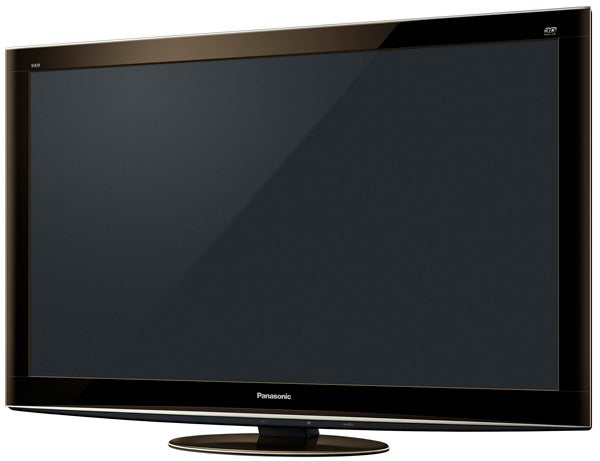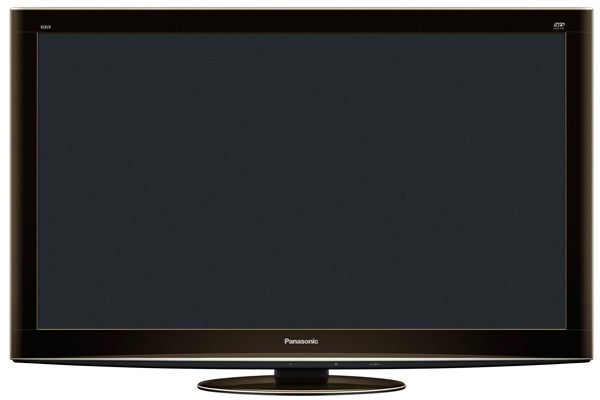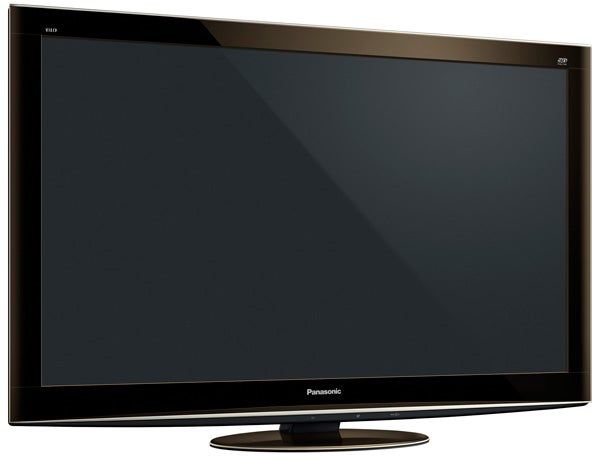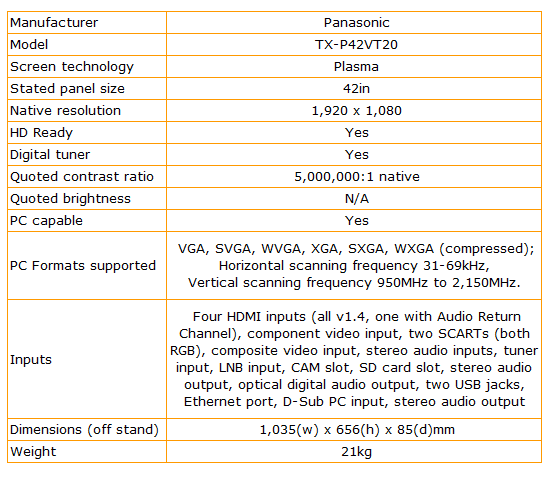Panasonic Viera TX-P42VT20B Review
Panasonic Viera TX-P42VT20B
This 42-inch plasma further consolidates the VT20 range's position as currently the most consistently watchable 3D televisions.

Verdict
Key Specifications
- Review Price: £1487.00
After recently feeling a touch underwhelmed by Panasonic’s new entry-level 3D screen, the P42GT20, we find ourselves on more predictably happy ground today with Panasonic’s flagship 42in 3D TV, the P42VT20.
For a start, the set actually has a vague stab at being stylish, thanks to its unusual brownish colour scheme. Despite this, though, the overall look remains almost painfully conservative, in keeping with almost all of Panasonic’s current TVs bar, perhaps, the multi-coloured D28 range.
The P42VT20’s connections are much more cutting edge. For as well as four v1.4 (and thus 3D capable) HDMIs, you get jacks for both Freeview HD and Freesat HD tuners, as well as plenty of multimedia support, including an Ethernet jack, a pair of USB ports, and an SD card slot. 
The Ethernet port, as we would expect of a flagship TV this year, enables you to access Freeview HD interactive features, files stored on a DLNA PC, and Panasonic’s online Viera Cast service, with its roster of ring-fenced content. The USBs, meanwhile, can play a selection of photo, music and video file formats. Or else you can insert a supplied dongle into one of them to make the TV Wi-Fi capable, or attach one of Buffalo’s JustStore Desktop HD-EU2-UK HDDs for instant recording from the built-in digital tuners.
As we’ve said many times, it’s a shame Panasonic’s recording system only appears to support a single USB storage brand. But at least the system does work well if you happen to have a suitable Buffalo drive lying around, with seemingly lossless-quality recordings of HD and standard def sources.
Viera Cast was arguably the leading online TV service for a brief moment when it first launched, and it still has arguably the most attractive and straightforward interface (a surprise given the dated look of most of the TV’s other menus). But while its content levels are solid, with highlights of the AceTrax movie purchase/rental service, Twitter, Eurosport, YouTube, and Skype, it’s now looking a little limited versus what some rival brands are offering.
Panasonic has apparently finally realised that the sort of person likely to buy a flagship level of TV might well be interested in endorsements from THX and the Imaging Science Foundation. The P42VT20 has both, with THX providing a really movie-friendly picture preset, and the ISF providing two professional picture setting slots that one of its engineers could use to calibrate the TV for you. It’s worth noting here that in order to access all the calibration tools the TV carries, you first need to activate an ‘Advanced’ (isfccc) option in the TV’s Setup menu.
If you do this, the options available include the facility to adjust the gain and cut-off levels of the red, green and blue colour components, and a series of gamma adjustments. This still doesn’t make the P42VT20 as comprehensive in the calibration department as we’d ideally like, but it’s a big improvement on anything Panasonic has done before.
Having previously reviewed the P42VT20’s bigger brother, the P50VT20, there doesn’t seem much point going into every single feature again here. So let’s just quickly run through the really key ones, namely a full HD resolution (unusual on a 42in plasma TV), 600Hz Sub-field drive processing, two pairs of 3D glasses included in the box, the use at the TV’s heart of Panasonic’s colour, brightness and contrast-boosting NeoPDP screen design technology, and Panasonic’s Intelligent Frame Creation system for reducing judder.
People who’ve followed the arrival of 3D from its earliest days will know that Panasonic originally seemed to deem it a format for the big screen, only initially launching 50in and 65in 3D models. And we have to say from first impressions of watching 3D on the new P42VT20 that we understand Panasonic’s big-screen thinking, for the impact of 3D is undoubtedly reduced on this smaller screen.
While this is worth mentioning, though, it isn’t fair grounds for actually dissing the TV. After all, it’s just been made to satisfy a market need, and still delivers a very fruitful 3D experience if you can sit quite close to it. 
What’s more, the P42VT20 definitely nudges its performance levels a good step or two higher than those of the aforementioned P42GT20. The main reason for this is that it has a richer contrast and black level, which helps deliver the finest black colour seen on a plasma TV since Pioneer’s still-legendary KURO models.
It’s no surprise from this to find that dark scenes are even more engaging, credible and above all natural than they were on the P42GT20. The same strength also helps the flagship model deliver a more well rounded and consistently convincing colour palette that’s especially noticeable when watching standard definition pictures.
It’s great to see, too, that the P42VT20’s class-leading black levels don’t come at the expense of shadow detail since, unlike all LCD screens, plasma’s per-pixel illumination system means there’s far less need to compromise the screen’s overall brightness output when showing a dark scene. Plasma’s self-illuminating properties mean, too, that you can watch the screen from a really wide angle without having to worry about the picture losing contrast or colour.
Next on our long list of positives, HD pictures look outstandingly sharp on the P42VT20, especially from Blu-ray discs. And this sharpness largely remains during action-packed scenes, thanks to plasma not suffering with the response time-related motion blur issues that LCD TVs do.
So far we’ve focussed on 2D pictures, but the P42VT20 continues to impress when asked to deal with an extra dimension. The main reason for this is that as with previous 3D plasma TVs we’ve tested, the P42VT20 suffers far less with the dreaded crosstalk ghosting artefact than any of its LCD-based rivals.
Crosstalk isn’t completely absent; we could certainly see it when playing ”Call Of Duty Black Ops” in 3D, and at times when watching Sky’s 3D channel. But it really is minimal in the context of the 3D TV world as a whole.
We want to add at this point that we tested the P42VT20’s 3D talents using a pair of Panasonic’s new 3D glasses, issued in response to the fact that the brand’s original 3D glasses were, well, rubbish, frankly. Unfortunately, though, the new ones are only marginally better. They’re more comfortable on your nose, which is a start, and are much less cumbersome in their form. But a combination of an over-shallow nose ‘gate’ and lenses that are two narrow means we either had to perch them at the end of our nose or else turn our head down slightly to use them effectively. Grr.
Going back to the TV’s picture quality, aside from the minor residual crosstalk there are a trio of other issues that stop the set from scoring a perfect 10 for pictures. First, images aren’t spectacularly bright, leading to a slightly heavy reduction in brightness and some lost shadow detail when watching 3D, as well as meaning that you ideally need a fairly dark room to get the most impact from the screen.
The other issues are the occasional appearance of dotting noise over skin tones during fast horizontal camera pans, and signs of judder during 50Hz viewing. At its worst, this can make scrolling backgrounds look jerky, so it’s as well that it can be reduced considerably with the help of the Intelligent Frame Creation system. Just make sure you only run this on its lowest setting strength, otherwise you’ll start to see a few unwanted processing side-effects.
Sonically, the P42VT20 rates as above average. Its soundstage isn’t quite as open and dynamic as we might have hoped considering that it actually uses a 2.1 speaker configuration with 30W of total power. But it’s definitely more effective and punchy than your typical flimsy flat TV audio effort.
Verdict
The P42VT20 certainly isn’t cheap for a 42in TV, especially when you consider that Samsung’s 50in PS50C6900 3D plasma TV can now be had for less than a grand. But the P42VT20’s pictures contain much more contrast than that Samsung model’s, and it suffers even less than the Samsung with crosstalk noise. All of which means that it consolidates the VT20 range‘s position as currently the most consistently watchable 3D tellies on the planet.

How we test televisions
We test every TV we review thoroughly over an extended period of time. We use industry standard tests to compare features properly. We’ll always tell you what we find. We never, ever, accept money to review a product.
Trusted Score
Score in detail
-
Features 10
-
3D Quality 9
-
Value 8
-
Design 7
-
2D Quality 9
-
Sound Quality 8
Features
| Size (Inch) | 46in, in |
| Display Type | LED |
| Max. Resolution | 1920 x 1080 |
| Digital Tuner | DVB-S2, DVB-T (MPEG4) |
| 3D Ready | Yes |
| Contrast Ratio | 5000000:1 |
| Refresh Rate (Hertz) | 60Hz |
Physical Specifications
| Height (Millimeter) | 695mm, 59.6mm |
| Width (Millimeter) | 308mm, 103mm |
| Depth (Millimeter) | 85mm |
| Weight (Gram) | 21g |

